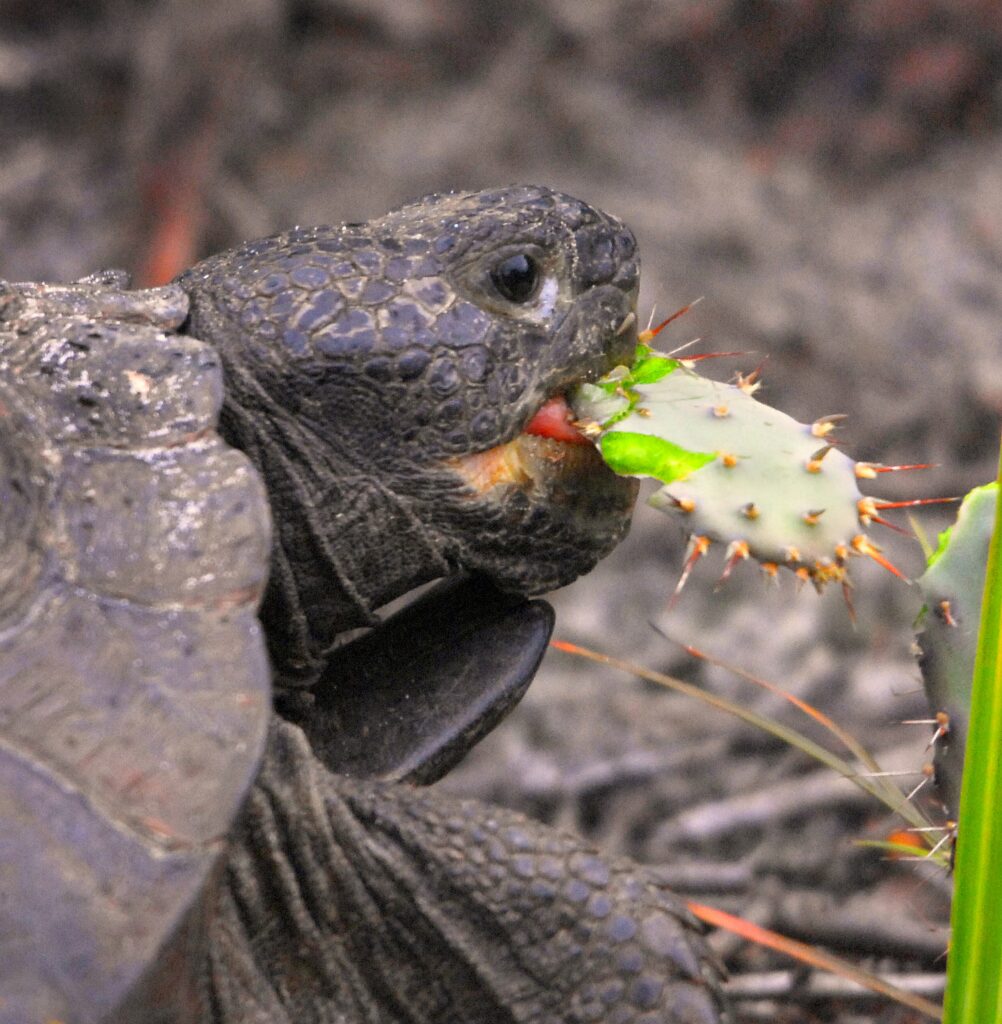
Image: Gopher Tortoise snacking on Opuntia Wikimedia Commons CC 2.0
Tortoises need proper hydration to stay healthy. Providing fresh water in a shallow dish makes it easy for them to access. Mist the enclosure to create a humid environment. Include hydrating fruits & veggies like cucumber, lettuce and strawberries in their diet. Offer a lukewarm soak once or twice a week so they can absorb moisture through their skin and drink.
Be mindful of overhydration, as it can be harmful. Balance between providing enough water and avoiding excessive moisture is key.
Follow these steps to keep your tortoise healthy & hydrated. Hydration is vital for their well-being and longevity.
Key Takeaways
- Tortoises require proper hydration to maintain their overall health and well-being.
- Providing a shallow water dish is essential for tortoises to drink from and soak in.
- The water dish should be cleaned regularly to prevent the growth of bacteria and algae.
- It is important to monitor the water temperature to ensure it is suitable for the tortoise.
- Tortoises may also benefit from occasional misting or spraying to increase humidity levels.
- Offering a variety of fresh fruits and vegetables can help supplement a tortoise’s hydration needs.
- Avoid feeding tortoises foods that are high in salt, as this can lead to dehydration.
- Regularly monitoring a tortoise’s hydration levels and adjusting their care accordingly is crucial.
- Consulting a veterinarian who specializes in reptiles can provide further guidance on proper tortoise hydration.
Understanding the water needs of tortoises
Tortoises need water in order to stay hydrated. It depends on their age, species, and environment. Therefore, put out a shallow bowl of clean water for them to access easily.
In addition, misting or soaking them in lukewarm water helps with their hydration levels and shedding skin. But, don’t submerge them in water as they can’t swim!
Monitor your tortoise’s hydration levels too. Signs of dehydration include sunken eyes, dry skin/shell, lethargy, and loss of appetite. Act fast if you see any of these signs and contact a vet.
To ensure your tortoise stays healthy and hydrated, provide them with an ample supply of water and regular misting/soaking sessions. Don’t wait – take action now to keep them hydrated! If they start wanting a pool cabana with palm trees, it may be time for a hydration check-up.
Preparing the water source and environment for hydration
Preparing the water source and environment for tortoise hydration involves ensuring the appropriate conditions for their well-being.
- Place a shallow dish filled with clean water in the tortoise’s enclosure. Ensure it is easily accessible for the tortoise to enter and exit comfortably.
- Keep the water source clean and change it regularly to prevent the buildup of bacteria or other contaminants. This will help maintain the tortoise’s health and prevent potential infections.
- Ensure that the environment surrounding the water source is suitable for the tortoise’s hydration needs. Maintain the appropriate temperature and humidity levels to support their overall well-being.
Additionally, provide a shaded area near the water source to prevent excessive exposure to direct sunlight, which can lead to dehydration.
It is important to note that tortoises have different hydration requirements based on their species, age, size, and health condition. Hence, it is recommended to consult with a veterinarian or reptile expert for specific guidelines tailored to your tortoise’s needs.
Interesting fact: Tortoises are known for their ability to survive without water for long periods of time. However, providing a proper water source is essential for their overall health and well-being. (Source: TortoiseTrust)
Remember, the only thing worse than a thirsty tortoise is a tortoise trying to drink from a shot glass.
Choosing the right water container
When choosing a water container, opt for one made of BPA-free plastic, stainless steel, or glass. Ensure it has a secure lid or cap to prevent leakage and contamination. Consider your daily water intake when selecting the size, and for those always on-the-go, go for one that is lightweight and easy to carry, like with a built-in handle or collapsible design.
Moreover, make sure it has a wide mouth or removable parts for easy cleaning and hygienic drinking water. Keep in mind that using reusable containers can help reduce plastic waste – with 1 million plastic bottles bought per minute, most of which end in landfills or oceans.
Choose your water container wisely so you get clean and safe drinking water throughout the day. Remember, the right water container can make all the difference to your hydration experience!
Ensuring clean and fresh water supply
A clean and fresh water supply is a must for proper hydration. Here’s how to ensure it:
- Clean and disinfect water storage containers regularly to avoid contamination.
- Install a reliable filtration system to remove impurities.
- Test the water quality often to meet safety standards.
- Store water in a cool and dark place to prevent bacterial growth.
For further security, consider these ideas:
- Get a reverse osmosis system for additional purification.
- Use stainless steel or glass bottles instead of plastic.
- Install a UV sterilization unit to kill harmful microorganisms.
- Add natural additives like lemon or cucumber slices for refreshment.
Now that you know how to guarantee a clean water supply, don’t miss out on the benefits of staying hydrated. Take action now and prioritize your health by following these practices. Your body will thank you!
Creating a suitable humidity level in the enclosure
- Measure the humidity using a hygrometer to assess if it’s too high or too low.
- Ventilate the enclosure to regulate the humidity.
- Put bowls of water around to increase humidity or utilize a humidifier designed for reptile habitats.
- Monitor water evaporation and adjust misting or use larger bowls if needed.
- Ensure the enclosure has proper heating elements to maintain a consistent temperature for optimal humidity control.
- Provide hiding spots and foliage to retain moisture and create microclimates.
- Add pieces of bark and moss to make the habitat more natural.
- Monitor the enclosure regularly and adjust accordingly to meet the reptile’s needs.
- Don’t forget to provide your reptile with an environment that mimics its natural habitat!
Spotting a dehydrated tortoise is as simple as finding a dinosaur in a swimming pool.
Take these steps to give your pet a home with the right amount of moisture, ensuring it thrives!
Identifying signs of dehydration in tortoises
Tortoises can easily suffer from dehydration: know the signs! Sunken eyes, dry skin, sluggish behavior, and darker urine are all clues your shelled friend may need more fluids.
Provide fresh water regularly to ensure optimal hydration levels. Dehydration can be dangerous, so access to clean water is essential. Plus, proper hydration helps regulate body temperature.
Pay attention and take action to keep your tortoise happy and healthy. Did you know? According to the Association of Reptilian Vets, dehydration can lead to urinary tract infections. Rehydrate your tortoise: a must for their shell-fie health!
Methods of hydrating tortoises

Tortoises require proper hydration to maintain their health. Here are some effective methods to ensure that your tortoise stays hydrated:
- Provide a water dish: Place a shallow dish of fresh water in your tortoise’s enclosure. This allows them to drink as needed and helps prevent dehydration.
- Soaking: Occasionally, you can give your tortoise a soak in lukewarm water. This helps them absorb moisture through their skin and promotes hydration.
- Moist foods: Including foods with high water content, such as leafy greens or fruits, in your tortoise’s diet can help increase their hydration levels.
- Mist the enclosure: Spraying a fine mist of water in the enclosure can create a humid environment, enabling your tortoise to absorb moisture through their respiratory system.
- Monitor urination: Keep an eye on your tortoise’s urination habits. If you notice a decrease in frequency or volume, it may indicate dehydration.
- Seek veterinary advice: If you have concerns about your tortoise’s hydration, consult a veterinarian who specializes in reptiles for personalized guidance.
By following these methods, you can ensure that your tortoise remains properly hydrated and healthy. Providing adequate hydration is crucial for their overall well-being and longevity. Don’t miss out on these simple yet essential steps to ensure the best care for your tortoise.
Give your tortoise a spa day with the soaking technique – just don’t forget the tiny cucumber slices for their eyes.
Soaking technique
- Fill a shallow container with room temperature water. Make sure it’s deep enough for the tortoise to submerge its shell, but not so deep that it can’t breathe comfortably.
- Gently place the tortoise in the container. Support its body and let it freely move around. Don’t make sudden movements or splash that may startle or stress the tortoise.
- Let the tortoise soak for around 20 minutes. Monitor their behavior to check if they’re comfortable and not showing signs of distress. Tortoises are unique; get guidance from a vet or reptile expert on frequency and duration of soaking sessions based on your tortoise species and individual characteristics.
- Also, give your tortoise access to fresh drinking water. Soaking is an effective way to hydrate, but they also need fresh water.
Here’s a story about the power of soaking: once upon a time, a pet owner noticed their tortoise was dehydrated. With guidance from their vet, they tried the soaking technique. After a few regular sessions, the owner observed remarkable improvement in the tortoise’s health and vitality. The tortoise became more active, had better appetite, and had a shiny shell!
Soaking is essential for tortoise health and well-being. Be careful, though—you don’t want to turn your tortoise into a feral weatherman with this mist spraying technique!
Mist spraying technique
The Mist Spraying Technique is a great way to hydrate tortoises! It involves spraying a fine mist of water onto their shell and body, like rain droplets that they’d normally encounter. This simulates the natural hydration process, as they often drink water droplets found on plants or rocks.
A spray bottle with a misting nozzle gives more control and ensures the water droplets aren’t too much. But be gentle – too much force may startle or stress them!
For extra effectiveness, use room temperature or slightly warm water, and spray them in a secure place like their enclosure. This technique is especially useful in dry seasons, when natural sources of moisture are scarce.
To get the most out of the Mist Spraying Technique, remember these tips:
- Observe your tortoise’s preferences for mist exposure.
- Create a misting schedule tailored to your tortoise’s needs.
- Use filtered or dechlorinated water.
- Monitor your tortoise’s behavior and physical condition.
These suggestions will help keep your tortoise hydrated and healthy. Who needs the fountain of youth when you can just give your tortoise a juicy watermelon slice?
Hydration through food
Hydrate your tortoise with food! Lettuce, cucumber, watermelon and tomatoes are great for keeping them hydrated throughout the day. Other options include zucchini, celery and strawberries, which offer varied flavours and provide essential nutrients too.
To ensure successful hydration through food:
- Give them a variety of hydrating foods.
- Serve fresh produce daily.
- Provide clean water alongside meals.
This will keep your pet hydrated and contribute to their overall health. Watering your tortoise doesn’t have to be a daily marathon – it’s slower than your internet connection!
Frequency and duration of hydration sessions
It’s key to know how often and how long to hydrate your tortoise for its health. Stick to a regular plan with this guide:
| Species | Frequency | Duration |
|---|---|---|
| Desert Tortoise | Every 2 days | 15-20 mins |
| Russian Tortoise | Daily | 10-15 mins |
| Sulcata Tortoise | Every other day | 20-30 mins |
| Greek Tortoise | Twice a week | 5-10 mins |
These are just the basics. Remember to customize to fit your tortoise’s needs.
Moreover, other factors to consider:
- Give clean water. Use a shallow dish or small container.
- Observe body language and behavior. If they seem disinterested, they’ve had enough.
To make it more effective and fun:
- Create a cozy environment. Put them near natural sunlight or UVB lighting.
- Offer fresh leafy greens. They provide moisture and nutrition.
- Soak fruits or veggies. This will entice them to drink and give a treat.
By heeding this advice, you can make a successful hydration routine for your tortoise. Watch them closely and adjust when needed. With proper hydration, your tortoise will be healthy and happy! Or, you know, just douse them in a bucket of Gatorade!
Supporting tortoise hydration with a balanced diet
Ensure your tortoise stays hydrated by incorporating high water content fruits and veggies, such as cucumbers, melons and leafy greens. Offer moist foods like soaked pellets or wet lettuce for added hydration. Monitor for signs of dehydration – sunken eyes, dry skin and lethargy – and increase water intake if needed. Try soaking them in shallow warm water for 15-20 minutes to help them absorb water through their vents. Mist the enclosure daily for a humid environment and ensure their diet meets their fluid requirements.
Remember, specific dietary needs may vary depending on the species. Consult a vet or reptile specialist for tailored recommendations.
Historically, ancient Egyptians highly valued tortoises as symbols of fertility and longevity. They believed juicy treats in ornate bowls would bring prosperity and abundance. So wrap your tortoise in a watermelon suit and watch it become the ultimate fruit ninja while staying properly hydrated!
Frequently Asked Questions
1. How often should I offer water to my tortoise?
Answer: Tortoises should have access to fresh water at all times. Change the water daily to ensure cleanliness and freshness.
2. What are some signs of dehydration in tortoises?
Answer: Common signs of dehydration in tortoises include sunken eyes, dry or wrinkled skin, lack of appetite, and dark-colored urine.
3. Can I just give my tortoise a bath to hydrate it?
Answer: While bathing your tortoise can provide some hydration, it is essential to offer drinking water as well. Drinking water ensures proper internal hydration.
4. What type of water should I offer my tortoise?
Answer: Use filtered or dechlorinated water for your tortoise. Avoid using distilled water as it lacks essential minerals.
5. Are there any hydrating foods for tortoises?
Answer: Yes, some hydrating foods for tortoises include fresh leafy greens (like lettuce and spinach), cucumbers, and melons. These foods can supplement the water intake.
6. My tortoise doesn’t seem to drink much water. What should I do?
Answer: Try offering water in different ways, such as using a shallow dish or misting the enclosure. If the issue persists, consult a veterinarian to rule out any underlying health problems.
Conclusion
Hydrating your tortoise is a must for good health. Water helps regulate their body temperature, aid digestion, and keep their shells healthy. Offer them a shallow dish of fresh water big enough to fit in and shallow enough to access. Change the water regularly. Misting or spraying with a fine mist bottle is another way to hydrate, just make sure you avoid their head and eyes. Fruits and veggies with high moisture content help too. A vet that specializes in reptiles can give you specific guidance for your individual tortoise. Hydrate your shelled friend for optimal health and well-being!
References




